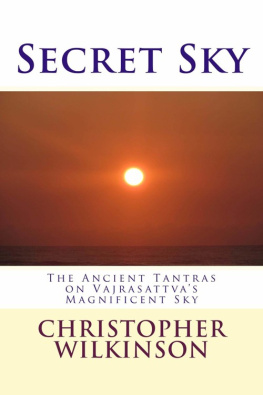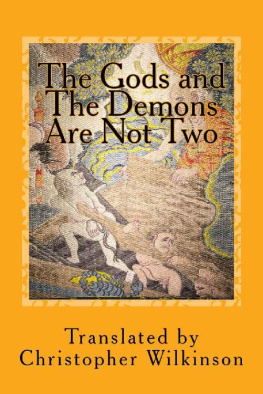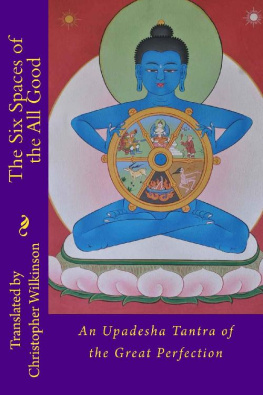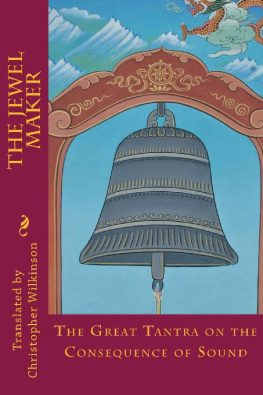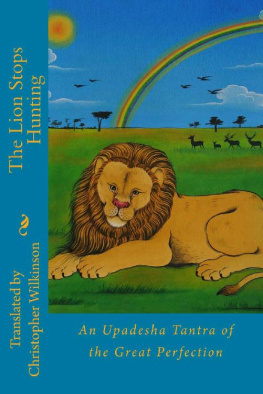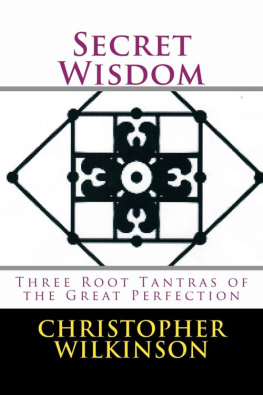Secret Sky The Ancient Tantras on Vajrasattva's Magnificent Sky With Tibetan Text Translations by Christopher Wilkinson No part of this book may be reproduced in any form or by any electronic or mechanical means including information storage and retrieval systems, without permission in writing from the author. The only exception is by a reviewer, who may quote excerpts in a review. Published by Christopher Wilkinson Cambridge, MA, USA Copyright 2015 Christopher Wilkinson All rights reserved. ISBN : 1512373400 ISBN-13 : 978-1512373400 DEDICATION For my daughter, Arwyn. Also translated by Christopher Wilkinson The Great Tantra of Vajrasattva: Equal to the End of the Sky Secret Wisdom: Three Root Tantras of the Great Perfection Beyond Wisdom: The Upadesha of Vairochana on the Practice of the Great Perfection The Sakya Kongma Series: Sakya Panditas Poetic Wisdom Jetsun Dragpa Gyaltsan: The Hermit King Admission at Dharmas Gate by Sonam Tsemo An Overview of Tantra and Related Works Chogyal Phagpa: The Emperors Guru Advice to Kublai Khan: Letters by the Tibetan Monk Chogyal Phagpa to Kublai Khan and his Court CONTENTS
| Acknowledgments | vii |
| Introduction | ix |
| The Tantra on Bodhicitta: Effulgent Vajra Light | |
| The Tantra of Vajrasattvas Magnificent Sky Embellished as The Unwritten | |
| The Tantra of Vajrasattvas Magnificent Sky Embellished for the Brahmins | |
| The Tantra of Vajrasattvas Magnificent Sky Embellished for the King | |
| The Tantra on Vajrasattvas Magnificent Sky | |
| The Tibetan Texts |
| The Tantra on Bodhicitta: Effulgent Vajra Light | |
| The Tantra of Vajrasattvas Magnificent Sky Embellished as the Unwritten | |
| The Tantra of Vajrasattvas Magnificent Sky Embellished for the Brahmins | |
| The Tantra of Vajrasattvas Magnificent Sky Embellished for the King | |
| The Tantra on Vajrasattvas Magnificent Sky | |
| About the Translator | |
ACKNOWLEDGMENTS First and foremost, I wish to thank my root teacher Dezhung Rinpoche for constantly bringing out the best in me and encouraging me to pursue a comprehension of every branch of Buddhist learning. It was he who introduced me to Dilgo Kyentse Rinpoche, and through his recommendations enabled me to receive full empowerments, transmissions, and permissions in the areas of Mah, Anu, and Ati Yogas.
With the highest regard I wish to thank Dilgo Kyentse Rinpoche, Khetsun Zangpo Rinpoche, and Khenpo Palden Sherab for their kind instruction and encouragement in my effort to translate the literature of the rDzogs chen. There are many individuals, too many to name here, that have helped me over the years to become a qualified translator, in many ways. At this time I want to remember the kindness of Ngawang Kunga Trinlay Sakyapa, Jigdral Dagchen Sakya Rinpoche, Dhongthog Rinpoche, H.H. Karmapa Rangjung Rigpay Dorje, Kalu Rinpoche, Chogyam Trungpa Rinpoche, Geshe Ngawang Nornang, David Ruegg, Turrell Wylie, Gene Smith, Karen Lang, Richard Solomon, Jack Hawley, David Jackson, Cyrus Stearns, Herbert Guenther, Eva Neumeier-Dargyay, Leslie Kawamura, Robert Thurman, Paul Nietupski, Lou Lancaster, David Snellgrove, Jean-Luc Achard, Steve Landsberg, Moke Mokotoff, Tsultrim Alione, Carolyn Klein, Rob Mayer, Jonathan Silk, David White, Mark Tatz, Steve Goodman, and Kennard Lipman. I want to make special thanks to Sarah Moosvi and Otavio Lilla for proofing the manuscript. The many people who have contributed to my understanding and ability to do this work cannot be counted.
I wish to thank everyone that has taken a kind interest in these translations, however slight, for your part in making this work a reality. INTRODUCTION The Tantras of Vajrasattvas Magnificent Sky, also known as the Unfailing Royal Insignia, come to us in manuscript traditions, books copied through the centuries, from Tibet and Bhutan. The texts are translations attributed to Vairochana, a famous translator of the eighth century, a Tibetan who went to India in search of the literature on instantaneous enlightenment, found it, and brought it back to Tibet. The original Indian texts have been lost in time. Vairochanas translations fill many volumes, The teachings on the Magnificent Sky are said to be oceanic in proportion. What we have, in terms of surviving manuscript traditions, is fifteen individual titles.
The two Tantras connected to the Guhyagarbha will be published in an upcoming volume. How do these teachings fit into the Buddhist tradition? Generally speaking, the vast array of the Buddhas teachings is divided up in many different ways, depending on the objectives of different schools and individuals. We often hear of the division between the Hinayana and the Mahayana, where a concern for personal liberation characterizes the first and an enlightened attitude based on great compassion for all sentient beings characterizes the latter. We hear of a division between the approach of the Sutras and the approach of the Tantras, where the first represents the practical approach of a gradual search for enlightenment through the development of generosity, rules, patience, perseverance, meditation, and wisdom, while the approach of the Tantras is usually based on a deity yoga in which special methods are employed in the hope of rapid enlightenment. The Tantras of the Magnificent Sky belong to a special class of Tantra, the Great Perfection, which does not employ deity yoga, rejects practices of visualization, and recommends instantaneous enlightenment. For those who follow the Ancient Traditions of Tibetan Buddhism, the Nyingma , this is the highest and most profound Buddhist teaching.
The schools of Buddhism in Tibet that are known as the New Schools, or Sarma, did not recognize the instantaneous approach as a true Buddhist teaching. The primary difference in opinion is that the New Schools insist that our progress toward enlightenment is a gradual process, while the Great Perfection teaches that enlightenment is instantaneous. We might say that while all the other pathways offered by Buddhism teach about becoming enlightened, the Great Perfection teaches about being enlightened. The Tantras of the Magnificent Sky are profound expressions of this approach. We have reason to believe that the authenticity of the Magnificent Sky Tantras was in doubt, even during Vairochanas lifetime. In the closing comments of The Sun of My Heart: A Hearty Elixir for Panditas and Siddhas, while speaking of the Magnificent Sky, Vairochana states: This has no resemblance to what Universal Monarchs or teachers like kyamuni have taught.
An investigation that will approve of or refute the ocean of upadea on the Unfailing Royal Insignia, which is the heart transmission of the All Good Garab, does not disturb my mind. I hope this will be a lamp for those whose fortune it is to see things partially. As you read the present translations, you will have an opportunity to evaluate these teachings from twelve-hundred years ago for yourself. During the early period of Buddhism in Tibet, the five Tantras that represent the Early Translations by Vairochana, including the Magnificent Sky, were said to address the concerns of the mind, Sems phyogs , while later on these Tantras were referred to as the Mind Section, or Sems sde , which is then differentiated from the Space Section ( kLong sde ) and the Upadea Section ( Man ngag sde ). These divisions are not found in the Tantras themselves, but represent the commentarial tradition that developed in Tibet. These Tantras have been faithfully copied as manuscripts over the centuries, and are found today in either the Hundred Thousand Tantras of Vairochana I include images of the pages of the manuscript for those who may be interested and to help preserve these ancient writings.
Next page
